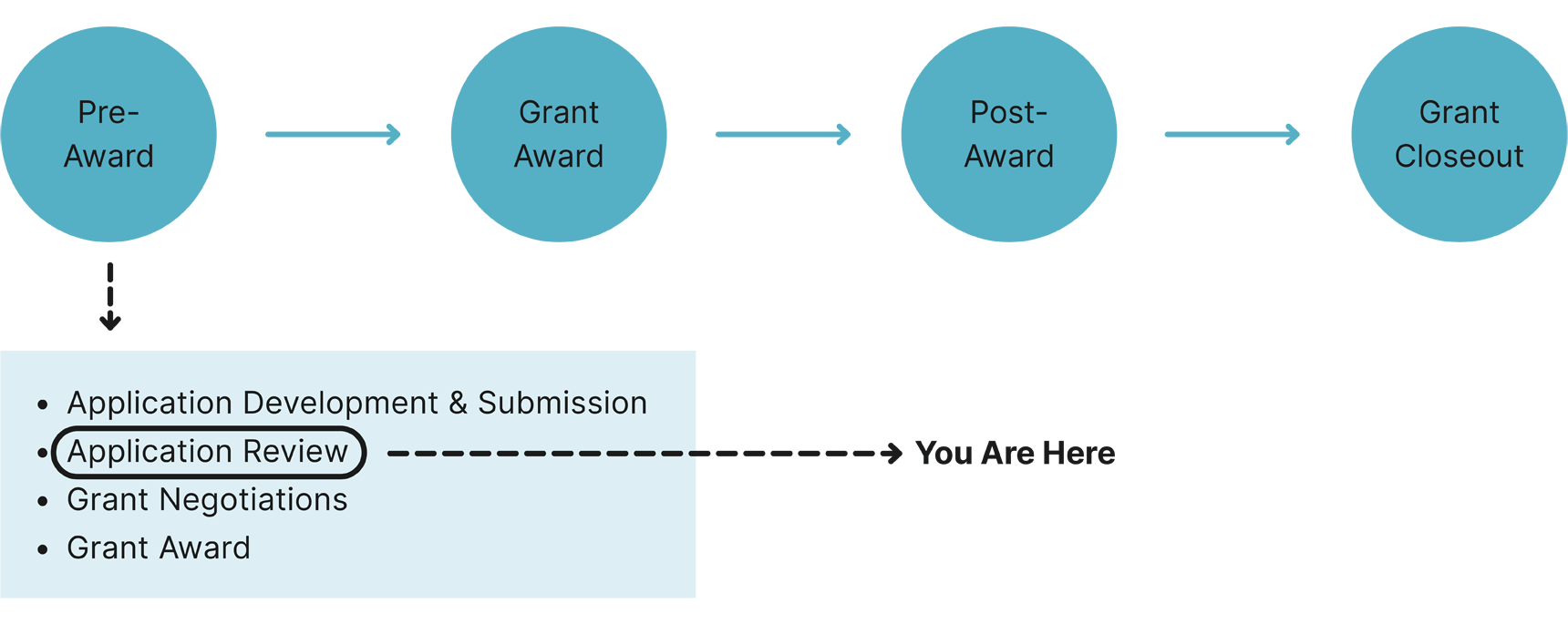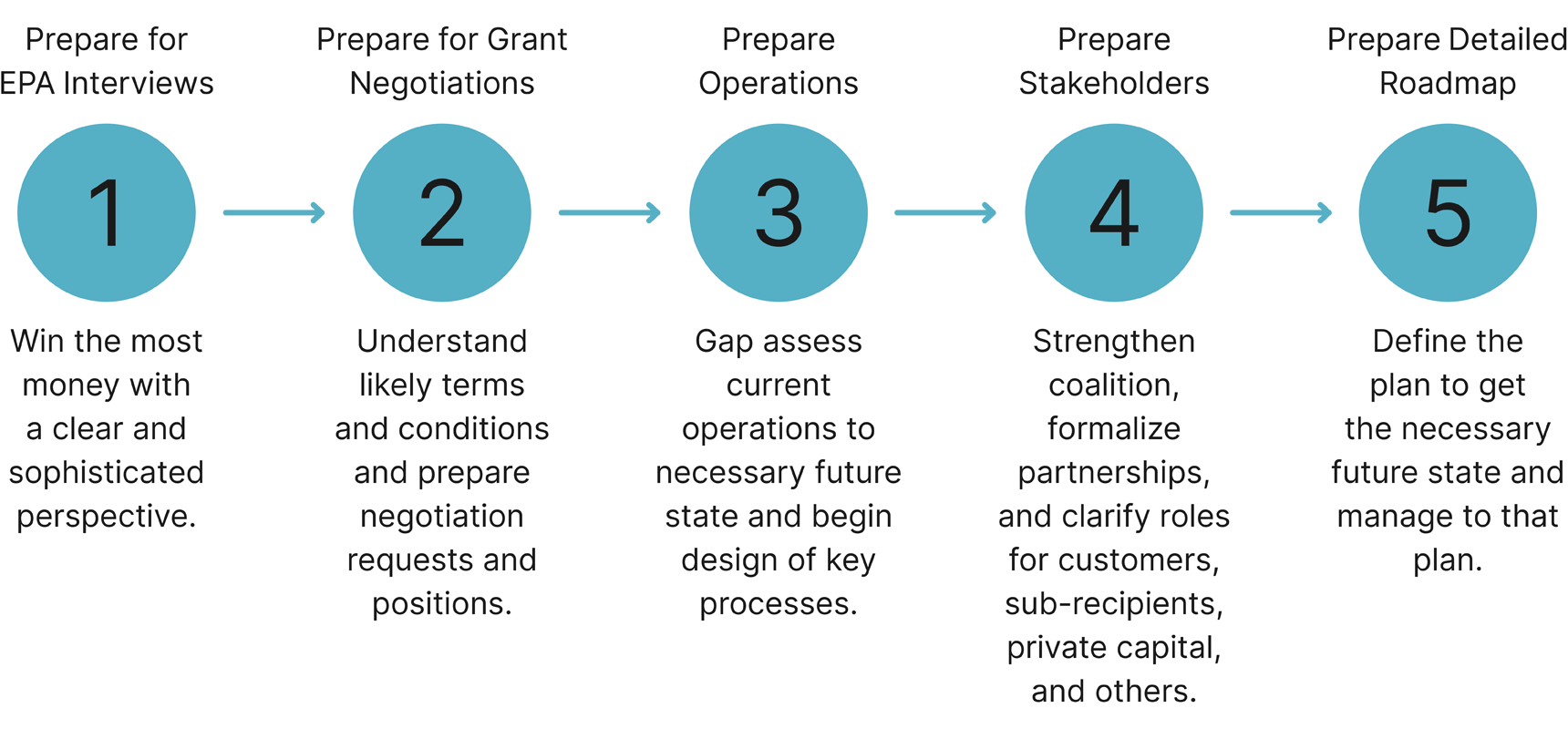 Search
Search


Congratulations! You made it past October 12, 2023, when applications to the $27 billion Greenhouse Gas Reduction Fund (GGRF) were due back to the U.S. Environmental Protection Agency (EPA).
So, what should you be doing next?
Your organization has already invested a significant amount of time, energy, and focus into positioning for funds under the GGRF in order to have an incredible impact for our communities, country, and environment. Meanwhile, banks and investors are about to knock on your door, ready to bring in significant additional private capital for the cause. The opportunity for impact is humbling, but the complexities you must navigate to achieve that impact can be daunting. And while you may be tempted to enjoy a well-deserved 5-month respite after the huge push to get applications into the EPA, there is still a significant amount of work to be done to prepare. As the adage goes, “Make hay while the sun shines,” and this time right now—the pre-award phase—is an often-overlooked period during which grant applicants can strengthen their operations and ready themselves for when the EPA calls to begin award negotiations. While it’s likely not practical to expend too many resources prior to receiving notice from the EPA that your entity will be receiving an award, there are some key items each applicant should focus on to prepare.


1. Prepare for EPA Interviews
Despite the sense of relief felt on October 13, the next step is not the receipt of funds. In its FAQs, the EPA has indicated that it will convene a review panel of subject matter experts who will evaluate all applications. Applications will be ranked in order of highest-to-lowest scores. Top-rated applicants may be invited for either a virtual or in-person interview process. It will behoove applicants to prepare for these interviews starting now and seek advice from those with deep experience and understanding of grants, and financial and risk management practices for programs with similar attributes. While some element of this readiness was demonstrated in the application, the application covered a very wide variety of topics, given the page limit. During these interviews, the EPA will no doubt probe deeper into your strategies around internal controls, reporting, compliance monitoring, and portfolio risk management. Therefore, it is likely that the EPA will have further inquiries on applicants’ capabilities and organizational preparedness to receive and deploy the funds.
2. Prepare for Grant Award Agreement Negotiations with EPA
After the interview process, the top-ranked applications will go through a “final selection process,” where the EPA will determine successful entities that demonstrate the best viability to manage and deploy this critical funding. Successful entities will likely be notified by Q2 in FY2024. At this time, entities will enter into the grant award agreement negotiation process. Entities can expect both specific terms and conditions that apply during the entire lifecycle of their grant awards, as well as certain pre-award conditions that EPA requires some applicants to meet prior to execution of the agreement. These pre-award actions may typically apply when an award application demonstrated a high level of risk associated with potential execution of the grant award. Certain risky applications (but with the potential of high reward) may also expect the EPA to convert their award into a cooperative agreement. Cooperative agreements enable the EPA to exert a significant amount of influence on the use of funds, as well as awardee operations. Therefore, it is critical that individual applicants be prepared for these extensive (and sometimes exhaustive) negotiations with the right experts at their sides.
3. Prepare Operations
While demonstrating organizational and operational readiness is important, some elements of building the plane while flying it are inevitable, given that many applicants are standing up new programs, and in many cases new entities. Some applicants may be receiving federal dollars for the very first time. Also, a good bit of the functions for operating the GGRF-related programs will necessarily be paid for from the grant funding.
So how do you get ready enough with limited resources? One important step is to prepare the high-level processes. You may not need detailed standard operating procedures yet, but you should have at least a playbook of process flows to take you from receipt of an award from EPA through evaluation of applications for funding, approval, and closing and disbursement. These new entities will also need to plan for the necessary financial and technology systems and infrastructure in place to expend, monitor, and report on hundreds of millions of dollars through several billion dollars in grant funding.
Getting this in place now allows you to identify the risks and control points and prepares you to quickly assign roles, prepare technology requirements, develop more detailed procedures, and train staff on the processes when the time is right.
4. Prepare Stakeholders
During the application process, most applicants established both formal and informal partnerships. From coalition members to entities that provided letters of support or letters of commitment, to the wide array of additional entities that will play an important role in the success of the entities’ GGRF program, each applicant has a variety of external stakeholders to engage and prepare. Further, each applicant has bodies such as boards of directors and advisory committees to keep informed and seek support and assistance from. Some entities, particularly those that applied for Solar for All, will have state agencies and officials to coordinate with. Ultimately this presents for each applicant a complex web of stakeholders to keep informed, aligned, and productively contributing in order to make the applicant’s GGRF program a success. Conducting a stakeholder analysis and developing a stakeholder engagement strategy focused on the next several months is a worthwhile activity for entities to execute now to progress their efforts to prepare and engage the right stakeholders at the right time in the right matters.
5. Prepare Detailed Roadmap
While it’s not practical to prepare everything right now, it is appropriate and advisable to develop a detailed roadmap and project plan for all that needs to happen, at least to get to the point of deploying funds to qualified projects. From governance and structure to people, processes, data, and technology, there is a lot to prepare. Having a detailed plan and sticking to it is not only necessary to effectively receive and deploy the funds for maximum impact and with appropriate rigor, it may give you a leg up as you enter negotiations with the EPA.
The roadmap should contemplate what needs to be designed, built, and documented; what needs to be acquired, including contractor support as well as technology; who needs to be trained on what; and who needs to be communicated with on what. It should include detailed timelines, assigned owners, and contemplate interdependencies across tasks. The roadmap should be the first step in establishing robust program management to get from the current state to the future state of the entity’s GGRF program contemplated in the application.
Guidehouse brings more than 30 years of sustainability consulting experience, combined with deep financial services, grants management, and digital expertise, all on one integrated platform to help you implement and operate your GGRF-related programs. From strategy, design, and build through to running the technology and operations, Guidehouse is uniquely qualified to help you on your GGRF journey. We bring more than 15 years of experience serving as the trusted partner for the federal government and state and local governments in implementing and operating financial assistance programs across a variety of grant, loan, and investment funding structures. Guidehouse also brings extensive experience assisting grant recipients with administering funds and adhering to compliance and reporting requirements. Guidehouse brings more than 17,000 professionals across more than 55 locations globally committed to helping our clients outwit complexity and create a lasting impact.
Guidehouse is a global AI-led professional services firm delivering advisory, technology, and managed services to the commercial and government sectors. With an integrated business technology approach, Guidehouse drives efficiency and resilience in the healthcare, financial services, energy, infrastructure, and national security markets.